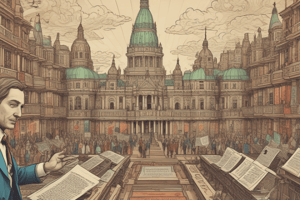Podcast
Questions and Answers
What are the welfare gains at Q0?
What are the welfare gains at Q0?
ABE
What is the cost at Q1?
What is the cost at Q1?
0BGQ1
How much was Eskom overpaying for the Kusile Coal Power Station?
How much was Eskom overpaying for the Kusile Coal Power Station?
over R4 billion
What was the overall loss of Transnet in 2023?
What was the overall loss of Transnet in 2023?
What was the budget for Transnet's locomotive acquisition?
What was the budget for Transnet's locomotive acquisition?
Transnet executives received increased salaries despite the company's losses.
Transnet executives received increased salaries despite the company's losses.
What economic theory provides tools to examine government behavior and policy motivations?
What economic theory provides tools to examine government behavior and policy motivations?
What is the Rawlsian Justice in Fairness theory?
What is the Rawlsian Justice in Fairness theory?
What does the Median Voter Theorem explain?
What does the Median Voter Theorem explain?
What is Logrolling?
What is Logrolling?
What does the Impossibility Theorem state?
What does the Impossibility Theorem state?
What does the Optimal Voting Rule theory propose?
What does the Optimal Voting Rule theory propose?
Which of the following are reasons for government failure?
Which of the following are reasons for government failure?
What is rent-seeking behavior?
What is rent-seeking behavior?
What is the Unanimity Rule?
What is the Unanimity Rule?
The Majority Voting Rule ensures that every decision has unanimous support.
The Majority Voting Rule ensures that every decision has unanimous support.
Flashcards are hidden until you start studying
Study Notes
Learning Outcomes
- Discuss the relevance of Rawlsian Justice in Fairness theory within South Africa's constitutional political economy.
- Evaluate the Median Voter Theorem and its implications on voting systems.
- Explain the Impossibility Theorem and its effects on social choice.
- Assess Logrolling (vote trading) and its potential to enhance Majority Voting systems.
- Analyze the self-interest maximization behaviors of politicians and bureaucrats, and their impacts on majority voting.
- Explore the origins and consequences of rent-seeking behavior.
Social Choice and Political Allocation of Resources
- Mixed economies include both private and public sectors.
- Private markets leverage the invisible hand for resource coordination.
- In the public sector, resource allocation is determined through voting and tax rates act as pricing mechanisms.
- Individual choices are transformed into social choices using various voting rules.
Rawlsian Unanimity Rule (RUR)
- Requires 100% agreement for decision-making.
- Targets the poorest, enhancing collective welfare as it follows a MaxMin strategy.
- RUR is the only Pareto efficient rule but decision-making costs are high, allowing minority vetoes.
Ordinary Majority Voting Rule (MVR)
- Direct democracy necessitates 50% + 1 vote for a proposal.
- Median Voter Theorem (MVT) posits that the median voter's preferences minimize collective welfare loss.
- Politicians may prioritize vote maximization, often influenced by personal and special interests rather than the public good.
Median Voter Theorem (MVT) in Action
- Example with National Health Insurance (NHI) highlights the importance of identifying the median voter.
- A preference for a 17.5% VAT indicates broad support across the voter distribution.
Social Choice in Coalition Government
- Surveys reveal citizen preferences for policy representatives, indicating varied support for coalitions among different party voters.
Arrow’s Impossibility Theorem (AIT)
- AIT asserts no social choice rule can produce consistent outcomes.
- Key assumptions include rational voter behavior, single-peaked preferences, and the independence of irrelevant alternatives.
- Voting paradox illustrated through intransitive preferences despite majority support.
Intensity of Preferences: Logrolling
- Majority rule may ignore preference intensity leading to suboptimal societal outcomes.
- Logrolling can occur through vote trading, fostering majority support without undermining minority preferences.
Optimal Voting Rule (OVR) by Tullock & Buchanan
- Suggests a potential rule outperforming dictatorship or majority rule by considering external costs and decision-making costs.
- Higher external costs necessitate greater consensus to prevent inefficient outcomes.
Government Failure
- Governments fail due to corruption, bureaucratic capture, and joint elite behavior.
- Politicians target special interests to maximize votes, often misleading costs leading to fiscal illusions and implicit logrolling.
- Result is an oversupply of unpopular public goods and significant economic inefficiencies.
Bureaucratic Behavior
- Bureaucrats aim to maximize budgets and sizes of their departments, resulting in X-inefficiency.
- Principal-agent problem occurs when bureaucrats’ goals diverge from citizens’ interests, leading to public good oversupply and rent-seeking behavior.
Price Gorging Example
- Eskom's mismanagement, including significant overpayments and corruption, exemplifies bureaucratic X-inefficiency and rent-seeking at the expense of societal welfare.### Opaque Procurement and Corruption
- Opaque procurement processes facilitate rent-seeking behaviors and encourage inflated tender prices.
- Corruption thrives in environments where transparency is lacking, impacting public resources and efficiency.
Transnet Financial Overview
- Transnet incurred a loss of nearly R6 billion in 2023.
- Executives at Transnet received over R87 million in salaries and benefits despite the organization’s financial struggles.
- There exists a disconnect between executive compensation and organizational performance, raising concerns about accountability and governance.
Economic Implications
- Public choice theory serves as a lens to analyze governmental economic behavior and policy motivations.
- Understanding who benefits from certain policies and who bears the costs is crucial in evaluating public sector decisions.
- The potential for real-world application of theoretical concepts may arise in examinations, utilizing case studies or data from credible reports like the Zondo or Nugent Commissions.
Exam Preparation Tips
- Focus on comprehension rather than rote memorization of concepts.
- Prepare to apply theoretical frameworks during assessments, recognizing the empirical implications of policies and executive actions.
Studying That Suits You
Use AI to generate personalized quizzes and flashcards to suit your learning preferences.





